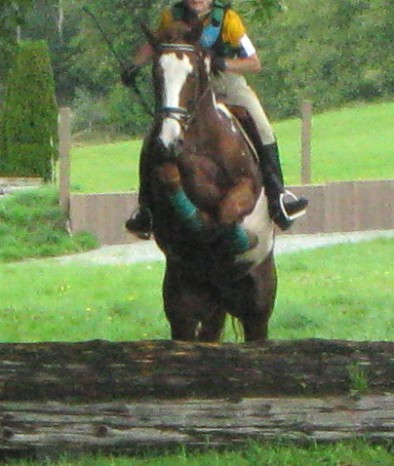Blondemare (aka Broodmare) recently wrote:
Had an interesting (good spirited disagreement) conversation with my vet this morning about what qualifies an intelligent horse and I’ve been mulling it over since he left. I had raised the point in direct correlation to breeds, specifically Arabians. He stated that Arabians can be a more difficult horse to work with, have a tendency to not tolerate even a rectal temperature check without a fight. He also stated that they require more sedatives on average to quiet them to a workable sense of consciousness for certain procedures. His take on the breed is that they are so intelligent that they sense danger more quickly than other horses. I respectfully disagreed. My thought is that behavior makes them over-reactive and flighty, that they rely on their flight mechanism every time something new, noisy, moving is encountered. No curiosity to the stimuli, only a fear reaction and wanting to escape the object/sound as quickly as possible. I find an intelligent horse to be one that processes information; one that thinks before running blindly into serious danger over a perceived threat.
I’ll use an example of a wooden ‘bridge’ I use to teach horses to accept the sounds of hooves on a noisy object, to prepare them for trailer loading and how to step up and down from an object. I use this bridge for all youngsters once they are lunging quietly; moving forward readily from a go cue, willingly spiraling out and away from me, whoaing and reversing from my body position.
I will approach the bridge and allow a thorough sniff-over, as long as it takes. After a good sniff, and in the case of many geldings, a paw or two may be used to test authenticity. After this, I’ll apply the go forward cue and most responses are hesitance, looking for a way around (I block away with the line, toward me with my body/energy, back with a whip or the line and only the front door is open), another good sniff and a half-hearted jump….next loop around I’ll get a foot on it and by the 3rd or 4th loop, most horses will give a good effort and put all fours on, looking quite proud of themselves I might add. Stop, reward, stand, repeat.
I present the challenge, tools in place, and ask the horse to make a decision – avoid fearful object and receive a correction or process information and apply it. I feel that when a horse applies the combination of aids, he is attentive, learning and responding to the education presented. Using thought and making a rational decision. Now enter Arab, given the same choices, the first decision when presented to the bridge is to jump into my space nearly knocking me down, and attempt to run off with tail in the air, eyes bulging out of the sockets, and no notable thought process. Second attempt is similar to the first though I’m ready and apply pressure via the lunge line firmly to the belly followed by a quick halt. Fleeing and knocking me to the ground, not acceptable options.
So….the process continues, 10 minutes later we are on loop 30? 40? doing what I asked, somewhat, which is getting over the bridge, but without contact. We are still in trot/jump mode. It’s like the 300th rerun of Pretty Woman, nice to watch but it gets old. A few more minutes, trot turns to walk, and an occasional hind hoof touches wood, horse is relaxing somewhat. Change directions, get one hoof on, quit for the day. Repeat again on day two, slightly less drama, still only 1-2 hooves on wood at any given trip around, though no longer attempting to flatten me. Quit. Day 3, 5 minutes, four hooves on. Stop, reward, rest, breathe. We got it done.
So I ask. Is the Arab smarter than a stock horse because he’s fearful and reactive to everything in his environment? Or is the horse that succeeds 20 times faster utilizing a process of thought the smarter individual? Me? I’ll take the thinker any day. I want a horse I can trust to take care of me, a horse that won’t over-react to a silly, nonsensical perceived threat and put my and his life in danger. I want a horse that has try, which lets me into his world, respects me and trusts me not to hurt him.
I’ve heard it said time and time again at various events from the Arab community that Arabians are the most intelligent breed of horse. They also state that you can’t do (enter request) with an Arabian because they won’t tolerate it as they are soooo smart. So I say to you, tell me why this is? Tell me why a horse that is flighty and willing to put himself in a precarious situation is smarter than my stock horse that removes snaps, opens latches, saunters to the grain room, opens a spin cap off the plastic cookie jug and has a feast of horse treats, without breaking the cap or the plastic jug. And when caught in action, comes right to me and offers a lip kiss across my cheek as in sucking up MAJORLY for being a bad girl.
So, what makes a smart horse and why? Is it self-preservation? Trainability? Cooperation? How do we give our horses a fair IQ test?


















